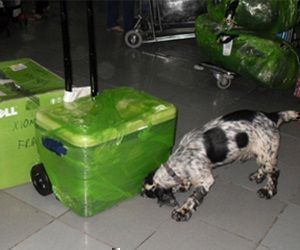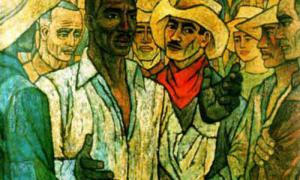Precious water
Cuba's new Water Law is focused on protecting water resources, with rational, efficient use
Author: Yisel Martínez |
informacion@granma.cu
january 15, 2018 16:01:51

Photo: Raidel Rodríguez
Water, a natural resource indispensable to human development, is employed in dissimilar activities, and its efficient use depends on correct management and rational usage. This is a goal Cuba has been working on for years, and was precisely the purpose of the country's new Terrestrial Waters Law, which has been under development since 2013 and was approved this past November 16, 2017.
Given the colonial history of the island, the first laws governing terrestrial waters came from Spain. The first, in fact, was called the Law of Spanish Waters (1871-1891).
With the triumph of the Revolution, Decree-Law 138 emerged in 1991. Many of its articles, however, were out of step with the situation Cuba faced during the Special Period, which was just beginning. Thus, over subsequent years it became that necessary to issue judicial norms to address the legislative vacuum existent in the country in regards to the issue.
The National Water Policy, approved in 2012, provided the lead-up to the most recent law, with a view toward comprehensive, sustainable management of terrestrial waters - a necessary step that allowed the legal framework to better serve the country's projections.
Since then, many were involved in creating the law: Central State Administration, the country's largest consumers, specialists from the National Institute of Water Resources, and other experts in the field.
"Proposals were submitted to different levels; the opinions of these persons were taken into account; changes were made and the draft was circulated in both the enterprise sector and government, represented in our case by delegations.
"The meetings with the National Assembly were very enriching. First a video-conference was held, in which the proposal was presented, and later meetings were scheduled throughout the national territory, in which deputies from the provinces participated, specialists from university centers, technical and enterprise arenas.
"Lastly, the opportunity was provided, for any one who wished to give their opinion via email," said Edilberto Pérez Blanco, lawyer and advisor from the National Water Institute's legal directorate.
As a result of this process, some 200 proposals were made and 37.7% of the original document was modified, taking into consideration suggestions made, many of which were incorporated into the law.
"It is a modern law, that not only takes into account the experienced gained over this time period in water management, but also addresses international commitments, such as meeting the 2030 Development Goals, the approval of Resolution 64 related to potable water, its purification as a human right, and all that is happening in the country directed toward perfecting legal norms," explained Pérez Blanco.
This law, he said, addresses the issue of supply, and incorporates the concept of comprehensive, sustainable management related to the impact of human activity on waters. An important element is that public services are assured water supplies at required levels, to minimize negative impacts on the population, viewing water as a resource for all.
Pérez continued saying, "The responsible use of water is being taken into consideration, in addition to the consequences and impacts that occur in different spheres of life. The law also attempts to reconcile humans with nature, taking into account adaptation to climate change."
Incorporated into the new law are protection of water resources; productivity and economic development; annual allotment plans; and recognition of the country's principal basins. Likewise addressed are ways water resources are used in the country; management of precipitation; the system of reservoirs; and flood control.
Pérez explained that the regimen included describes water quality and quantities available, to make projections possible, along with results from periodic studies of rainfall, resources and other issues that "contribute to better management and use of the resource."
Likewise, the roles of several different entities are addressed in the law. For example, licenses from the Ministry of Interior for navigation on lakes and rivers are defined, and in terms of fees, since this is a centralized process in Cuba, the Ministry of Finances and Prices, as well as the Council of Ministers, are involved. The allotment plan, on the other hand, in which planning water usage as required is addressed, the Ministry of Economy and Planning is called upon to participate.
"As studies were done, we sought to complement other legislation on the topic, and to include some principles related to the management of terrestrial waters," he continued.
The new law includes regulations that define steps to be taken to fulfill certain requirements established, Pérez stated, "Among these we can find how to obtain authorization to use water supply infrastructure. Who are the authorities one must seek out; the documents to be presented for certain permits; document terms of validity; the resources one can use in a given request; how to proceed to cancel an authorization; and many other questions."
According to Pérez Blanco, the law's greatest strength is its practical nature, based in Cuba's reality: "The decree-law took more than 15 years, and the practice, the studies, the international experience - from which we have also learned about water management - allowed us to create a law that addresses the care of water and additionally fits perfectly with the context in which we find ourselves.
Nevertheless, he believes the greatest challenge will be building consciousness, given that the law in fitted to the country and the world's situation, including adaptation to climate change, an accelerating phenomenon. "Protecting the environment is not an obligation of the state, but of all citizens. Pressure must be put on institutions, in the best sense of the word, on the National Institute of Water Resources, on all those implicated, so that this effort has visible results soon," he insisted.
The new Law of Terrestrial Waters arrives as a needed tool to achieve efficient use of this resource. Accomplishing everything it sets out will depend on how the precious liquid is used and the capacity of relevant institutions to manage it.
THREE OBJECTIVES OF THE LAW
- Structure the comprehensive, sustainable management of terrestrial waters as a renewable but limited resource, to serve the general interests of society, the economy, health, and the environment.
- Establish measures to protect terrestrial waters on the basis of planning, conservation, and sustainability, in harmony with socio-economic development and protection of the environment.
- Establish measures for the protection and adaptation of society, the economy, the environment, and terrestrial waters to the negative impact of extreme weather events and climate change."
http://en.granma.cu/cuba/2018-01-15/precious-water







